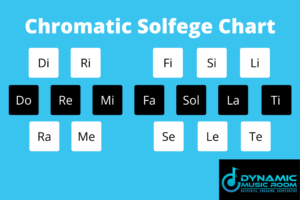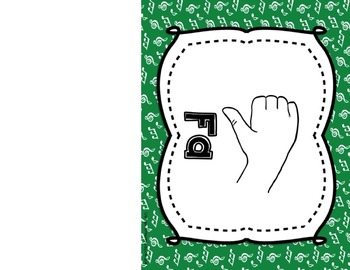

In this case, the first explanation above applies - we will continue to use sharp notes ascending and descending to match the scale. An example G chromatic scaleįor this example - the chromatic scale in the key of G, let's assume that we are working with a key that is on the circle of 5ths - G major scale, which is a sharp-based key signature, and we want to identify some chromatic scale notes outside that key. when playing the notes from lowest to the highest pitch, then use flats when descending.
#CHROMATIC SOLFEGE HOW TO#
Chromatic scales without a key signatureįor both C major key signature and A natural minor key signature, there are no sharp or flat notes, so since there is no key signature, we have no clue as to whether to use sharp or flat names to identify any non-natural notes.Īlthough there seem to be no generally agreed rules on how to handle this, one common music theory convention is to use sharps when ascending the scale ie. Eb major key signature, where flat note names would be used. The same principle applies to flat-based key signatures, eg. G major key signature, and we want to use the chromatic scale to identify notes outside that scale, sharps would be used for those chromatic scale notes. major scale, or any minor scale), then the key signature will be the guide as to whether to use sharps or flats for the chromatic scale.įor example, if a sharp-based key signature is used, eg. If chromatic scale notes are being used and identified within the context of a scale with a key signature (eg. Chromatic scale naming in the context of a key signature When it comes to naming the notes shown in the last step, the decision to be made is whether to use sharp or flat note names, both ascending or descending.

For example, C, C♯, and C♭ (as well as Cdouble sharp and Cdouble flat, not shown above) are all sung with the syllable "do".This step gives note names to the piano keys identified in the previous step.
#CHROMATIC SOLFEGE DOWNLOAD#
This download includes: 8. This is a visual and kinesthetic exercise that is paramount in developing confident and accurate singing. "In the fixed do system, shown above, accidentals do not affect the syllables used. Tonic sol-fa (solfege) cards placed on a wall, bulletin board, or behind a door are a fantastic learning center in your teaching studio. and the rest (sharps and flats they think or mind as it is written in the sheet notes: Rachmaninov, Prelude en do dièse mineur (-> C# minor)īut actually the French just sing the non-altered name - also DO for C# and MI for Eb etc. These expressions are used to name the key!ġ.1 Suite française no 1 en ré mineur, BWV 812ġ.2 Suite française no 2 en ut mineur, BWV 813ġ.3 Suite française no 3 en si mineur, BWV 814ġ.4 Suite française no 4 en mi bémol majeur, BWV 815ġ.5 Suite française no 5 en sol majeur, BWV 816ġ.6 Suite française no 6 en mi majeur, BWV 817 The names are like Tim says correctly "do-dièse" (C#) and "mi bémol" (Eb) etc. Is that correct? Does anyone know the standard way of fixed-do solfege in the scale with key signature and accidentals? | la la ti ti | do re re mi | mi fa fa sol | la la sol | sol fa fa mi | mi re do do | ti ti la | Ignoring accidentals is very easy but E sharp will be "mi", etc. In this episode we explore the two methods of Chromatic Solfege Singing and how they apply to Ear Training, Music Production, Performance and overall develop. I have no idea whether I should just ignore accidentals or indicate actual note. Is that correct? Fixed-do/non-chromatic is more complicated. | la li ti do(?) | di re ri mi | fa(?) fi sol(?) si | la la si | sol fi fa mi | me re di do | ti te la | I am not sure but in fixed-do/chromatic should be like: I don't know how to read notes with accidentals. | do di re ri | mi fa fi sol | si la li ti | do do ti | te la le sol | se fa mi me | re ra do |īut I am very confused with Fixed-do. In movable-do/chromatic, it should be like: | do do re re | mi fa fa sol | sol la la ti | do do ti | ti la la sol | sol fa mi mi | re re do | In movable-do/non-chromatic, it should be:

The image below is A major scale with accidentals.

There are also variations such as chromatic and non-chromatic. As far as I studied, There are 2 different ways in solfege, fixed-do and movable-do. I am learning solfege by myself and I have a question about reading of notes with accidentals.


 0 kommentar(er)
0 kommentar(er)
